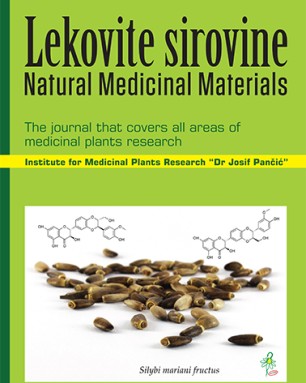Faculty of Medicine, University of Nis , Niš , Serbia
Department of Pharmacy, Faculty of Medicine, University of Nis , Niš , Serbia
Department of Pharmacy, Faculty of Medicine, University of Nis , Niš , Serbia
Faculty of Medicine, University of Nis , Niš , Serbia
Department of Physiology, Faculty of Medicine, University of Nis , Niš , Serbia
Department of Pharmacy, Faculty of Medicine, University of Nis , Niš , Serbia
Polyphenols are secondary plant metabolites with proven antioxidant activity, which have an important part in prevention of many diseases. Pineapple (Ananas comosus (L.) Merr. family Bromeliaceae) is a plant native to Central America. Pineapple fruit is the most common part of plant used in both, nutrition and traditional medicine, but other parts of the plant also have certain healing properties. Plant material, originating from Colombia, was purchased at a local market. The peel and crown leaves of the fruit were separated, dried and extracted with absolute methanol, 80% methanol and 60% methanol in 1:10 ratio. The juice was prepared by the crushing of the fruit pulp in a blender and filtering. Total phenolic content (TPC) was determined using Folin-Ciocaltеu method and the antioxidant capacity was estimated in 1,1-diphenyl-2-picrylhydrazyl (DPPH) system. The highest TPC was determined in the 60% methanol leaf extract (25.94 ± 3.54 mg GAE/g) while the lowest TPC was detected in pineapple juice (0.79 ± 0.07 mg GAE/g). Pineapple fruit peel extract in absolute methanol showed the highest antioxidant capacity (IC50=1.745 ± 0.046 mg/ml), while the lowest antioxidant capacity was estimated in pineapple juice (IC50=88 ± 2.09 mg/ml). The significant amount of polyphenols in pineapple fruit extracts and juice indicates their high antioxidant activity, thus these extracts and juice have a potential to be used in prevention and treatment of various diseases. It is, however, necessary to perform additional in vivo and in vitro studies in order to verify pharmaceutical effects of these extracts and juice, and to examine their possible toxicity.
This is an open access article distributed under the Creative Commons Attribution License which permits unrestricted use, distribution, and reproduction in any medium, provided the original work is properly cited.

The statements, opinions and data contained in the journal are solely those of the individual authors and contributors and not of the publisher and the editor(s). We stay neutral with regard to jurisdictional claims in published maps and institutional affiliations.